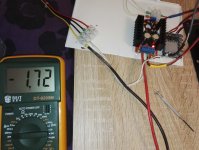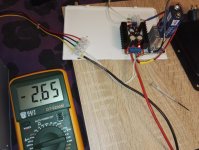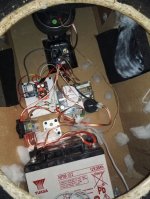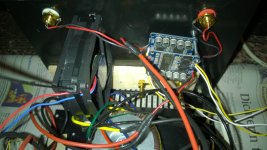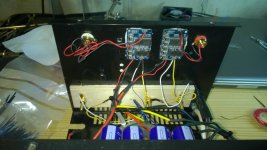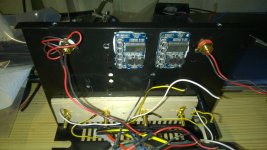What is the measured power voltage (in DC volts) and what is the load (in ohms)?and the chips were too hot to touch for more than a few seconds. Is that normal?
Kapton sheet the size of the boards, thermal paste on both sides of the kapton sheet, and 4 bolts. Yeah, sort of heatsink the whole board, for transferring heat out of the board and into the metal case.Does anyone have an idea how to mount these tiny boards inside a metal case?
I was only listening at 72-75 dbA at around 2 meters from the speakers and the chips were too hot to touch for more than a few seconds. Is that normal?
I tested this chip with a tiny heatsink@29v and an 8 ohm Monacor SP-15/300PA/MRD-120 and had serious thermal issues, even in Idle the heat sink was like 70°C hot.
The Chip also always ran into thermal shutdown for a fraction of a second, when the bass kicked in at very high listening levels(>110db), which is much more annoying than clipping.
So I would not recommend this chip for PA purpose, and will switch to a TDA7498.
At first I tested this chip at 6 ohm and measured about 18W continuous power with a tiny heatsink and 28W with tiny heatsink+ some stuff lying on it before thermal limit.
Attachments
The DC voltage is 27V; the speakers are 8 ohms.What is the measured power voltage (in DC volts) and what is the load (in ohms)?
@Jimbeam: I´m not planning on pushing this little chip so hard. It´s just for background music. I hope I don´t run into thermal problems at moderate volume (80 dbA).
I was able to get some 3mm screws and I mounted an 80mm fan inside the case. That should help. I am not done with the cables yet. I need to lengthen some and tidy them up with cable straps.
Attachments
If I read the datasheet right, the heatsink goes on the back. It takes a big thermal pad, the size of the board. That and some paste.
Other ways to cool it off:
Use model "BTW" instead and/or lighten the load (SE mode will do that) and/or lower the voltage.
Other ways to cool it off:
Use model "BTW" instead and/or lighten the load (SE mode will do that) and/or lower the voltage.
The fan keeps the chips cooler, but it´s way too loud!
I´ll probably just glue the boards with silicone to the case and see what happens.
If all else fails, I´ll order a LM3886 board.
This was supposed to be a fast, easy, cheap projekt. It hasn´t been fast, easy or cheap.
I´ll probably just glue the boards with silicone to the case and see what happens.
If all else fails, I´ll order a LM3886 board.
This was supposed to be a fast, easy, cheap projekt. It hasn´t been fast, easy or cheap.
I tested this chip with a tiny heatsink@29v and an 8 ohm Monacor SP-15/300PA/MRD-120 and had serious thermal issues, even in Idle the heat sink was like 70°C hot.
The Chip also always ran into thermal shutdown for a fraction of a second, when the bass kicked in at very high listening levels(>110db), which is much more annoying than clipping.
So I would not recommend this chip for PA purpose, and will switch to a TDA7498.
At first I tested this chip at 6 ohm and measured about 18W continuous power with a tiny heatsink and 28W with tiny heatsink+ some stuff lying on it before thermal limit.
Nice battery, nice woofer and nice horn tweeter you have there.
The tweeter should be similar to the MHD 55, right?
I have the MHD 55 and it sounds pretty good above ~2.5kHz.
I guess this stuff is used / going to be used in a mobile system.
In the pic i see something that looks like a passive x-o.
I don't know how much that attenuates the total SPL.
But with an approximately 100db @ 1W sensitivity of the speaker you should achieve pretty decent SPL.
Achieving more than 110db with a 3 EUR amplifier is more than anyone would have expected some years ago.
And the amp does that with very good efficiency.
The strength of that tiny amp module is not high output power.
The expectations should not aim for that.
All three TDA7498 boards i know suit high SPL application much better.
Maybe that is not (only) because of the chip, but (also) because of the board designs with bigger traces, bigger inductors, bigger heatsinks...
Other options are the TI TAS56xx series amps which are old enough to be sold at typical chi-fi prices.
They bring 4Ohm capabilities and easy PBTL modifications (2Ohm) which might be required...
Do you use this as a mono system?
Maybe bi-amping with an active line level x-o is an option for you.
This and a two channel sanwu TDA7498 work great in mobile setup.
Maybe mini-dsp is an option for you?
Did you change the 7498 for the 8932 in hope of higher SPL?
Higher SPL especially into 8Ohm loads is only possible with higher voltage and current.
Before you'll be able to find out if a TAS5630 firing into a 4 Ohm configuration of your drivers gives you what you want, your voltage converter will run into its limit.
For a forceful boombox a TDA7498 or TAS5611 and bi-amping seems like the perfect solution to me.
Anything bigger than that needs a stack of batteries to achieve at least +-50V and IRS2092 based amps.
I don't know if my blabla helps.
It sums up in:
Don't try to get more out of it if you are not willing to pay extra money and carry more stuff around.
Thank you for your feedback, yes this is a mono system and the boombox was actually in use with this chip quite recently at the deichbrand festival near Hamburg. Many people were surprised about the output power, sound quality and battery life of this thing. They probably wouldn't believe that the amp was that small.
The x-o actually lowers the SPL of the tweeter with a Resistor to fit the SPL of the woofer. But it doesn't affect the woofer SPL that much and I don't think that the extra Efficiency above 3khz is worth the hassle going active.
I bought this board(Did not arrive yet) TDA7498
Yeah, the converter is a little problem, although it works pretty good.
Putting 3 Batteries in series would be the best solution, but I already bought this battery 2 years ago and don't want to invest more money. The TAS5611 might be a bad idea because it's only specified for voltages up to 32V, unlike the TDA7498 that can perfectly handle the 39V of 3 Batteries in series, which is very important if I want to upgrade the batteries in the future.
The x-o actually lowers the SPL of the tweeter with a Resistor to fit the SPL of the woofer. But it doesn't affect the woofer SPL that much and I don't think that the extra Efficiency above 3khz is worth the hassle going active.
I bought this board(Did not arrive yet) TDA7498
Yeah, the converter is a little problem, although it works pretty good.
Putting 3 Batteries in series would be the best solution, but I already bought this battery 2 years ago and don't want to invest more money. The TAS5611 might be a bad idea because it's only specified for voltages up to 32V, unlike the TDA7498 that can perfectly handle the 39V of 3 Batteries in series, which is very important if I want to upgrade the batteries in the future.
Last edited:
I have 4 of the tda8932 boards. Two I have installed into a powered setup for the 9yo grandson. Figured he would like the deeper bass of this amp board. It sounds nice, not too much detail and fuller bass than 3116 boards have-inmstock form. I would really like to mod the other two to get a sense of audiophile bliss. I can pair with practically any load/size drivers as I can put together a pair in a day.
My problem is you mostly talk in EE speak in regards to the mods! Would someone be kind and do a write up for a novice, on what to purchase, where and how to utilize the components and an illustration or two?
even buy a couple of these resistors and put them here, these caps go here. So I can try audiophile sound on the cheap, please.t hanks
My problem is you mostly talk in EE speak in regards to the mods! Would someone be kind and do a write up for a novice, on what to purchase, where and how to utilize the components and an illustration or two?
even buy a couple of these resistors and put them here, these caps go here. So I can try audiophile sound on the cheap, please.t hanks
I glued the boards to the metal case with silicone, and it made a HUGE difference!
The chips only get modestly warm, as the case absorbs and dissapates the heat. I covered the solder pads on the underside of the board with tiny pieces of electrical tape, to prevent a short if they made contact with the case.
I am very pleased with the audio quality of these tiny amps 🙂
The chips only get modestly warm, as the case absorbs and dissapates the heat. I covered the solder pads on the underside of the board with tiny pieces of electrical tape, to prevent a short if they made contact with the case.
I am very pleased with the audio quality of these tiny amps 🙂
Attachments
Thank you for your feedback, yes this is a mono system and the boombox was actually in use with this chip quite recently at the deichbrand festival near Hamburg. Many people were surprised about the output power, sound quality and battery life of this thing. They probably wouldn't believe that the amp was that small.
The x-o actually lowers the SPL of the tweeter with a Resistor to fit the SPL of the woofer. But it doesn't affect the woofer SPL that much and I don't think that the extra Efficiency above 3khz is worth the hassle going active.
I bought this board(Did not arrive yet) TDA7498
Yeah, the converter is a little problem, although it works pretty good.
Putting 3 Batteries in series would be the best solution, but I already bought this battery 2 years ago and don't want to invest more money. The TAS5611 might be a bad idea because it's only specified for voltages up to 32V, unlike the TDA7498 that can perfectly handle the 39V of 3 Batteries in series, which is very important if I want to upgrade the batteries in the future.
Very good chosen amp board!
It has two channels, so bi-amping is an option for you.
As long as you keep the passive x-o
(which is a good choice as long as you don't want to invest money in a dsp solution or invest money and lots of time for the design of an opamp based active x-o)
you must take care to not destroy the amp by using a dummy load on the unused channel.
Honestly i'm a bit jealous of your woofer....
Don't be to disappointed if the new amp doesn't bring stellar improvements in SPL and sound quality.
The sound quality of what you have already is very good for class d amp.
SPL will be limited by the converter as i already said.
I think the forum member 'doctormord' investigated some tweaks around the exact same converter.
The next improvement for you might come with a subsonic filter.
This keeps the amp from wasting energy for the very low notes which you have no chance to reproduce with a system like this.
I glued the boards to the metal case with silicone, and it made a HUGE difference!
The chips only get modestly warm, as the case absorbs and dissipates the heat. I covered the solder pads on the underside of the board with tiny pieces of electrical tape, to prevent a short if they made contact with the case.
I am very pleased with the audio quality of these tiny amps 🙂
Yes!
Most little chip amplifiers that are plastic on the top. . . are supposed to heatsink through the bottom.
If you'd like a bigger surprise, you could add an additional TDA8932 in SE / STEREO mode, just for powering two tweeters.Thank you for your feedback, yes this is a mono system and the boombox was actually in use with this chip quite recently at the deichbrand festival near Hamburg. Many people were surprised about the output power, sound quality and battery life of this thing.
Also, mind the thermals for the woofer-only bridge amp so that it doesn't thermal limit prematurely.
Double the effective output power (the woofer amp won't make the tweeter amp clip) and four times the treble resolution, in stereo. . . is a head start on hearing why one more chip might be fun for driving your tweeters.
Sure do wish someone would try this so we could get a better job on the explaining than I could do.
Hi Daniel,
as interesting as your suggestion with the amp in SE for tweeters sounds for home use or small boomboxes, i think it is not what JimBeam is looking for.
He has a big boombox with professional PA-drivers.
He is looking for higher output power with sound quality similar to what the TDA8932 delivers.
Adding another tweeter is no option for his application.
I have a similar problem.
I look for a mono amp to feed an even bigger tweeter horn.
Single channel use of a TDA7498 might work, but it is not really what i am looking for.
I would like to make a serious comparison between all china d-amps in my stock, but i do not have the time atm.....all those projects and my holydays are almost over....
as interesting as your suggestion with the amp in SE for tweeters sounds for home use or small boomboxes, i think it is not what JimBeam is looking for.
He has a big boombox with professional PA-drivers.
He is looking for higher output power with sound quality similar to what the TDA8932 delivers.
Adding another tweeter is no option for his application.
I have a similar problem.
I look for a mono amp to feed an even bigger tweeter horn.
Single channel use of a TDA7498 might work, but it is not really what i am looking for.
I would like to make a serious comparison between all china d-amps in my stock, but i do not have the time atm.....all those projects and my holydays are almost over....
My suggestion (and the previous heatsink comment) doubled his effective power even if he didn't add another tweeter. It is because with the tweeter only amp added, then the tweeters can't replay the woofer clipping on the now-separate amp.Hi Daniel,
as interesting as your suggestion with the amp in SE for tweeters sounds for home use or small boomboxes, i think it is not what JimBeam is looking for.
He has a big boombox with professional PA-drivers.
He is looking for higher output power with sound quality similar to what the TDA8932 delivers.
Adding another tweeter is no option for his application.
It is this: Lower your expectations on what one amplifier should be doing; and, then your two amplifiers are much more likely to fulfill your desires.
I haven't used TDA7498, ST's baby, and therefore, I have a total lack of anything direct to say about it.I have a similar problem.
I look for a mono amp to feed an even bigger tweeter horn.
Single channel use of a TDA7498 might work, but it is not really what i am looking for.
I would like to make a serious comparison between all china d-amps in my stock, but i do not have the time atm.....all those projects and my holydays are almost over....
Each manufacturer does do the datasheet information far differently and consistently so. It is like flipping to a whole different channel. What you should choose depends on your goals on what the output should be like. So, if you want the results fast, the choose a good match. It mostly does concern the documentation.
I have personal reasons to suspect that all of the electronic bits are excellent and capable. In this opinion, I think that the utilization difference is up for careful consideration.
The matter is not so different from a high end zoom lens. The options there are to throw the performance to the wide end, which I love for maximum performance with a big view, at expense that the zooming in is pointless, or maximized cowardice with the performance in the center-point resulting in mediocre performance without exception, or maximum performance at the long distance at the expense of average use with terrible results. So, you've got some choices to make. If you want to start by defining the application and its goals more carefully and thoroughly, then the selection efforts can be much easier.
A fair reconnoiter might help.
Mind the usage.
I do not get how the ouput power is doubled in SE mode.
I thought you were connecting a woofer in BTL for more output and the tweeters in SE for better quality at the cost of spl....
I thought you were connecting a woofer in BTL for more output and the tweeters in SE for better quality at the cost of spl....
The load is doubled in BTL, which results in more effort and more heat from the amplifier, at the expense of halved quality, which isn't a problem with a woofer.I do not get how the ouput power is doubled in SE mode.
Output power isn't doubled in SE mode; and, in fact, the bulk output power is less in SE mode by 2x~3x.
Audio finery, perhaps in the form of resolution is doubled in SE mode. That was the only thing doubled in SE mode.
I most certainly did that. I did it with ONE chip. The one chip did both of those things simultaneously, albeit in mono.I thought you were connecting a woofer in BTL for more output and the tweeters in SE for better quality at the cost of spl....
On a personal note, the prospect of enjoying that has been motivating for some time. That fact also can affect my opinion of it.
Last edited:
Could someone explain how to wire 1 or two of these in stereo with one power supply? I'd like to try them.
They're rather easy to use and usually have a most pleasant tone in most applications (no exceptions so far). So, I suggest to try them and then report back with requests on what you'd like them to do better. Sure, that is doable. But, I'm suggesting that you might enjoy the experience if you go ahead and play with them. Philips/NXP did a really good job with the protection, which we have tested (far and beyond). So, it could be fruitful and at minimum cost, to just play with them. After the information from that experience, I request that you report back with descriptions on what you'd like them to do better.Could someone explain how to wire 1 or two of these in stereo with one power supply? I'd like to try them.
Not only is the durability helpful (because I won't test Class-D with any mercy), but also the several different capacities for entertainment potential have withstood my testing, all the while never causing me to get bored with it and never causing much expense either.
If you intend to use it for an audio amplifier, try it for that which it is for, and break it, then you might be the first.
Do, play it in the form indicated by the vendor. It will probably be pretty and work. My post have much to do with the fact that you can enjoy higher resolution by asking it do that.
I might have neglected to mention that it is enjoyable in stock form, used as simply as possible. I was rather more concerned with the fact that most Class D really can't do high end, this one can, and the effort and expense for it is minimal. So, my concentration wasn't really on that initial effort on getting it up and running. Initially, it will do mid-fi with a really pretty tone. I have lots of those. I designed most of them. The hard part is the path forth from better than attractive. This chip has that capacity. And while the ultimate is not convenient, I suspect that this chip puts that in reach at the lowest cost.
No matter if you have employed this durable little thing for a taste of what mid-fi should sound like (the typical use) or an optional taste of what hi-fi should sound like (slightly more bother to wire it), it is not likely to disappoint.
- Home
- Amplifiers
- Class D
- Fasten seat belts. TDA8932 pessimistic review.
